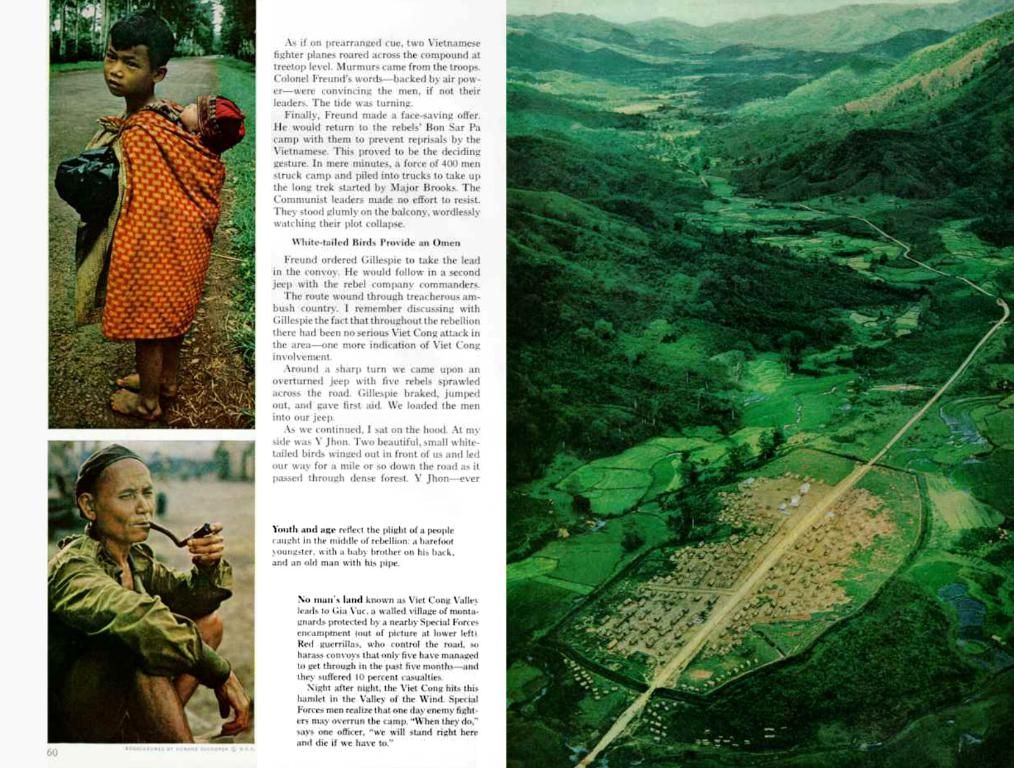Uranium Concerns Over Kyzyl-Ompol Field Dismissed by Kyrgyzstan Authorities
Not-So-Sterile Scenario:
In the heart of Kyrgyzstan, plans to tap into the riches beneath Lake Issyk-Kul's shimmering waters have locals on edge, but few dare to speak their mind due to the suffocating grip of fear. Last month, President Sadyr Japarov toured the city of Balykchy, trying to soothe frayed nerves about the controversial Kyzyl-Ompol field.
"During his big show, Japarov promised over a grand job creation spree at Kyzyl-Ompol," grumbled Kubatbek Baiterekov, a frustrated villager of Kyzyl-Ompol who attended the meeting. "He compared it to the infamous Kumtor gold mine and swore all profits from the uranium dig would pour into the government's greedy hands."
Officials in Japarov's camp claim that the state-run company will oversee the operation, promising they'll only play it safe. And they've attempted to quiet concerns by claiming Kyzyl-Ompol is mostly about fetching titanomagnetite, an ore used for steel production and medical device manufacturing.
But whispers around the impending development of Kyzyl-Ompol have been simmering for close to five years. Back in 2019, local protesters rallied against exploration work carried out by Russian firm UrAsia Kyrgyzstan, compelling the authorities to revoke the company's license. Now, however, voices of dissent are being steadily silenced through suppressive measures, allege rights watchdogs.
Japarov even went as far as forcing attendees of the Balykchy consultation to cast a show of hands, with everyone sheepishly backing the project. One hesitant participant spoke anonymously, "What could we do? They drove us from our villages and hrded us in Balykchy. Five years ago, we held a rally, and then the authorities listened to us. Now, with critics of the government behind bars, even some MPs, we're too scared to voice our disagreement."
While there were some protests in Balykchy, they were muted out as Japarov asked about a 2019 moratorium on geological studies aimed at uncovering uranium and thorium deposits. "Japarov curtly dismissed the moratorium," Baiterekov confirmed, adding that the dig will churn out a whopping 14.8 million tons of minerals, with 95% being titanomagnetite and the remaining 0.17% being uranium.
Mining engineer Omurbek Kasymbekov shed light on the confusing information circling Kyzyl-Ompol, saying it may explain the panic. Previously, the government had enticed foreign investors with misleading licenses indicating considerable uranium deposits at Kyzyl-Ompol, he claimed. Furthermore, Kasymbekov conceded that while titanomagnetite is the primary target, there are other minerals, such as phosphorus, zirconium, thorium, and uranium, present in the deposits, albeit in smaller quantities.
As energy baron Akylbek Japarov, the head of the Cabinet (no relation to the president), triumphantly boasted the field held deposits worth a whopping $300 billion, some MPs expressed concerns about the environment and public health. Elvira Surabaldiyeva, a vocal MP, recently argued against mining uranium deposits, citing the precedent of toxic tailings from Soviet-era uranium mining in southern Kyrgyzstan, which still pose a threat to the local population's health.
Kyzyl-Ompol is located above Issyk-Kul, so any dust, dirt, or debris produced there will inevitably end up in the lake. This isn't music to the ears of environmentalists like Kalia Moldogaziyeva, who warn that even tiny amounts of uranium present near titanomagnetite can still pollute the environment and harm human health during extraction and transportation. Moldogaziyeva also warned that eradicating uranium residues from the 43,000-hectare site would be a daunting task.
Usually, whispers of discontent find their way onto social media, but even those forums are eerily quiet about Kyzyl-Ompol. Elnura Tashmatova from Karakol claims she received threats from the State Committee for National Security (the successor agency to the KGB) after voicing her opposition to uranium mining on social media. Tashmatova felt compelled to remove her critiques out of fear of prosecution on trumped-up charges. Similar stories about threats against Kyzyl-Ompol opponents abound, and activists claim that they are warned of arrest if they attempt to rally opposition to the project.
- The controversy surrounding Kyzyl-Ompol has also sparked discussions in the realm of environmental-science, with concerns about potential pollution of Lake Issyk-Kul and its surrounding environment.
- In light of the upcoming development at Kyzyl-Ompol, the health implications of uranium extraction have become a point of debate within the health sector, with some citing the threats posed by toxic tailings from Soviet-era uranium mining.
- The political realm has not been spared from the impact of the Kyzyl-Ompol issue, as some MPs have raised concerns about the environmental impact and public health risks associated with uranium mining.
- Amidst the growing silencing of dissenting voices, questions about the integrity of news reporting on the Kyzyl-Ompol project have emerged in the general-news sphere, with allegations of suppressive measures and threatening tactics used against critics.








